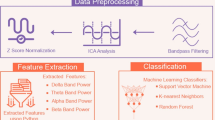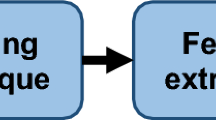Abstract
This paper presents the automatic genre classification of Indian Tamil music and western music using timbral features and fractional Fourier transform (FrFT) based Mel frequency cepstral coefficient (MFCC) features. The classifier model for the proposed system has been built using K-nearest neighbours and support vector machine (SVM) classifiers. In this work, the performance of various features extracted from music excerpts have been analyzed, to identify the appropriate feature descriptors for the two major genres of Indian Tamil music, namely classical music (Carnatic based devotional hymn compositions) and folk music. The results have shown that the feature combination of spectral roll off, spectral flux, spectral skewness and spectral kurtosis, combined with fractional MFCC features, outperforms all other feature combinations, to yield a higher classification accuracy of 96.05 %, as compared to the accuracy of 84.21 % with conventional MFCC. It has also been observed, that the FrFT based MFCC, with timbral features and SVM, efficiently classifies the two western genres of rock and classical music, from the GTZAN dataset, with fewer features and a higher classification accuracy of 96.25 %, as compared to the classification accuracy of 80 % with conventional MFCC.












Similar content being viewed by others
References
Ahrendt, P., Larsen, J., & Hansen, L. K. (2007). Temporal feature integration for music genre classification. IEEE Transactions on Audio, Speech, and Language Processing, 15, 1654–1664.
Ashok Narayanana, V., & Prabhu, K. M. M. (2003). The fractional Fourier transform: Theory, implementation and error analysis. Microprocessors and Microsystems, 27, 511–521. doi:10.1016/S0141-9331(03)00113-3.
Bang, S.-W., Kim, J., & Lee, J.-H. (2013). An approach of genetic programming for music emotion classification. International Journal of Control, Automation and Systems, 11(6), 1290–1299. ISSN 2005-4092. doi:10.1007/s12555-012-9407-7
Banitalebi-Dehkordi, M., & Banitalebi-Dehkordi, A. (2014). Music genre classification using spectral analysis and sparse representation of the signals. Journal of Signal Processing Systems, 74(2), 273–280. doi:10.1007/s11265-013-0797-4. ISSN 1939-8115.
Baniya, B. K., Ghimire, D., & Lee, J. (2014). A novel approach of automatic music genre classification based on timbral texture and rhythmic content features. In 16th International conference on advanced communication technology (ICACT), 16–19 February 2014 (pp. 96–102).
Becchetti, C., & Ricotti, K. P. (1999). Speech recognition: Theory and C++ implementation. Chichester: Wiley.
Benetos, E., & Kotropoulos, C. (2010). Non-negative tensor factorization applied to music genre classification. IEEE Transactions on Audio, Speech, and Language Processing, 18(8), 1955–1967.
Betsy, S., & Bhalke, D. G. (2015). Genre classification of Indian Tamil music using Mel-frequency cepstral coefficients. International Journal of Engineering Research and Technology, 4(12). doi:10.17577/IJERTV4IS120465. ISSN 2278-0181.
Bhalke, D. G., Rao, C. B. R., & Bormane, D. S. (2014). Musical instrument classification using higher order spectra. In International conference on signal processing and integrated networks (SPIN), 20–21 February 2014 (pp. 40–45). doi:10.1109/SPIN.2014.6776918.
Bhalke, D. G., Rao, C. B. R., & Bormane, D. S. (2015). Automatic musical instrument classification using fractional Fourier transform based-MFCC features and counter propagation neural network. Journal of Intelligent Information System. doi: 10.1007/s10844-015-0360-9.
Cataltepe, Z., Yaslan, Y., & Sonmez, A. (2007). Music genre classification using MIDI and audio features. EURASIP Journal on Advances in Signal Processing, 2007(1), 1–8. doi:10.1155/2007/36409. ISSN 1687-6180.
Chen, X., & Ramadge, P. J. (2013). Music genre classification using multiscale scattering and sparse representations. In 47th Annual conference on information sciences and systems (CISS), 20–22 March 2013 (pp. 1–6).
Chen, S.-H., Chen, S.-H., & Guido, R. C. (2010). Music genre classification algorithm based on dynamic frame analysis and support vector machine. In IEEE international symposium on multimedia (ISM), 13–15 December 2010 (pp. 357–361).
Chen, S.-H., Chen, S.-H., & Truong, T.-K. (2012). Automatic music genre classification based on wavelet package transform and best basis algorithm. In IEEE international symposium on circuits and systems (ISCAS), 20–23 May 2012 (pp. 3202–3205).
Fu, Z., Lu, G., Ting, K. M., & Zhang, D. (2011). A survey of audio-based music classification and annotation. Multimedia IEEE Transactions, 13(2), 303–319.
Gaikwad, S., Chitre, A. V., & Dandawate, Y. H. (2014). Classification of Indian classical instruments using spectral and principal component analysis based cepstrum features. In International conference on electronic systems, signal processing and computing technologies (ICESC), 9–11 January 2014 (pp. 276–279).
Ghosal, A., Chakraborty, R., Dhara, B. C., & Saha, S. K. (2012). Music classification based on MFCC variants and amplitude variation pattern: A hierarchical approach. International Journal of Signal Processing, Image Processing and Pattern Recognition, 5(1), 131–150.
Jothilakshmi, S., & Kathiresan, N. (2012). Automatic music genre classification for Indian music. In International conference on software and computer applications (ICSCA 2012), IPCSIT (Vol. 41).
Kini, S., Gulati, S., & Rao, P. (2011). Automatic genre classification of North Indian devotional music. In National conference on communications (NCC), 2011, 28–30 January 2011 (pp. 1–5). doi:10.1109/NCC.2011.5734697.
Krishnaswamy, A. (2003). Application of pitch tracking to South Indian classical music. In Proceedings of IEEE international conference on acoustics, speech and signal, 6–10 April 2003 (Vol. 5, pp. V-557–V-560).
Kumar, V., Pandya, H., & Jawahar, C. V. (2014). Identifying ragas in Indian music. In 22nd International conference on pattern recognition (ICPR), 24–28 August 2014 (pp. 767–772). doi:10.1109/ICPR.2014.142.
Li, T., & Ogihara, M. (2006). Toward intelligent music information retrieval. IEEE Transactions on Multimedia, 8, 564–574.
Li, T., & Tzanetakis, G. (2003). Factors in automatic musical genre classification of audio signals. In IEEE workshop on applications of signal processing to audio and acoustics, 19–22 October 2003 (pp. 143–146).
Lim, S.-C., Lee, J.-S., Jang, S.-J., Lee, S.-P., & Kim, M. Y. (2012). Music-genre classification system based on spectro-temporal features and feature selection. IEEE Transactions in Consumer Electronics, 58(4), 1262–1268.
Nagavi, T. C., & Bhajantri, N. U. (2011). Overview of automatic Indian music information recognition, classification and retrieval systems. In International conference on recent trends in information systems (ReTIS), 21–23 December 2011 (pp. 111–116). doi:10.1109/ReTIS.2011.6146850.
Panagakis, Y., & Kotropoulos, C. (2013). Music classification by low-rank semantic mappings. EURASIP Journal on Audio, Speech, and Music Processing. doi:10.1186/1687-4722-2013-13. ISSN 1687-4722.
Rao, P. (2012). Audio metadata extraction: The case for Hindustani classical music. In International conference on signal processing and communications (SPCOM), 22–25 July 2012 (pp. 1–5). doi:10.1109/SPCOM.2012.6290243.
Salamon, J., & Gomez, E. (2012). Melody extraction from polyphonic music signals using pitch contour characteristics. IEEE Transactions on Audio, Speech, and Language Processing, 20(6), 1759–1770.
Scaringella, N., Zoia, G., & Mlynek, D. (2006). Automatic genre classification of music content: A survey. IEEE Signal Processing Magazine, 23(2), 133–141.
Tamil music. http://www.carnatica.net/tmusic.htm.
Tzanetakis, G., & Cook, P. (2002). Musical genre classification of audio signals. IEEE Transactions on Speech and Audio Processing, 10(5), 293–302. doi:10.1109/TSA.2002.800560.
Vedanayagam Sastriar. http://www.sastriars.org/.
Zeng, Z., Zhang, S., Li, H., Liang, W., & Zheng, H. (2009). A novel approach to musical genre classification using probabilistic latent semantic analysis model. In IEEE international conference on multimedia and expo, ICME 2009, 28 June–3 July 2009 (pp. 486–489).
Acknowledgments
We wish to thank JSPMs Rajarshi Shahu College of Engineering, Savitribai Phule Pune University, Pune, India for providing the lab facilities.
Author information
Authors and Affiliations
Corresponding author
Rights and permissions
About this article
Cite this article
Rajesh, B., Bhalke, D.G. Automatic genre classification of Indian Tamil and western music using fractional MFCC. Int J Speech Technol 19, 551–563 (2016). https://doi.org/10.1007/s10772-016-9347-3
Received:
Accepted:
Published:
Issue Date:
DOI: https://doi.org/10.1007/s10772-016-9347-3




